Painting with Abandon — Artwork and Text by Janet Paparelli
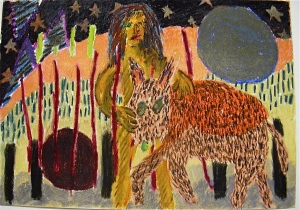
Me and the Art Dog 2/82
Pastel on Paper 9.5″x13.5″
In writing about the subject of painting with abandon, I can foresee myself writing my way into a corner. As I mentally browse my work of the last 35 plus years, I ask myself a previously unasked question, i.e. which ones of these would I designate as having been realized with abandon.
Living with abandon in the real world could be, at its worst, perilous, and at its best, messy.
Counter Attack Nov. 1984
Tempera on Paper 18″x24″
What works in fine art, doesn’t work in life and vice versa.
I usually march to the beat of that famous distant drummer which most successful people (air quotes) and even some artists don’t hear. So, as usual, I am writing for an extremely small audience with whom I may have something in common.
Talking Around It (1971) (Or: My Audience is Getting Smaller & Weirder Every Day)
Acrylic on Canvas 36″ x 30″
Immediately I think of a canvas that I call Almost Happy — I remember painting it.
Almost Happy Nov. 2001
Oil on Canvas 66″x54″
I remember standing in front of the blank canvas thinking: ” I don’t want to do any sketches or preparatory drawings. I won’t draw on the canvas itself– I will just attack it” , leaving self somewhere behind and using myself only as an instrument through which color and form pass–not evaluating as I go, not thinking about what’s going to happen, but allowing things to happen from the beginning of the painting to the end of the painting. The larger the work the more difficult to access and maintain abandon to the work’s completion.
In beginning a painting, the first mark, the first color and the placement of either one of those, the size of the canvas, or other surface on which one is working, can dictate one’s direction. One is almost compelled to follow a certain path depending on which mark, color, or material one has applied moments before. It’s as if one owes something to that mark or color etc. to complement it, to balance it. Abandon means not to pay attention to any of that.
Biting In Dec. 1981 [Yikes! This definitely screams “abandon”!]
Oil on Canvas 26″x28″
To paint with abandon is to not owe anything to the marks one made moments before. You don’t owe them anything. Approaching painting in this way, one must decide to be fearless at the outset and continue to be fearless ’til the end.
Action, and not thinking, dominate over judgment and decision-making.
It’s Spring and I’m 47 1989
Charcoal/Paper 17″x14″
Action, sadly, is a word loaded with images of paintings from the 1940’s, a term which carries baggage built up over the years by the peripheral people in the arts (curators, writers, professors, etc.) whose opinions and terminologies have overshadowed the words of the artists, themselves, in describing their own works.
Torn Grid (1999)
Oil on Paper 11.75″ x 8″
The preconception of having a strong idea of what a good painting is, can result in producing a rather mediocre work of art.
It’s an idea that works against one, in that one tries to comply with the preconception, which never results in originality.
Over the Sofa Sept. 1989
Oil Bar/Paper 26.5″x31″
I have done some mediocre work which owes itself to having been victimized by my having tried to comply with this idea, i.e. the preconception of what a good painting is. It’s a tricky thing–kind of sneaks up on one. Sorry, but I couldn’t find any mediocre work to insert in this text.
[“Too bad”, said she, and she cried all the way into posterity.]
White Painting with Triangles 2002
Oil on Panel 12″x18″
Trying to make a good painting results in not being able to make a good painting. The ideas of success or failure in what one does shouldn’t even enter into it. Approval, disapproval, understanding, analyzing, self-importance, painting for some future unknown audience, are not part of this. These are accessories piled onto art work by the peripheral colony of the auxiliary arts professions previously exampled (previously mentioned above, i.e. critics, professors, etc.). One just does the work.
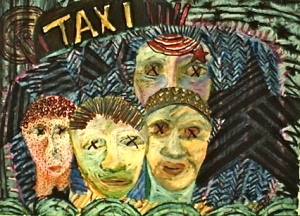
TAXI 7/82 (Paris)
(Alternative title: I’m the Curator! No! I’m the Curator!)
Oil Crayon/Paper 22.5″x30″
One can be so trapped in one’s own confinements acquired over the years, that departing from them by stepping off into the nothingness and deep space of the unfamiliar can be quite an uncomfortable experience. It is difficult to be fearless, but it is worth the effort nevertheless.
Drawn & Quartered 1984 (Alternative Title: The Paparelli Scream)
Tempera/Paper 18″x24″
In reviewing the works I’ve done over the years, I’ve tried to identify those I’ve done with at least some fearlessness, the fearlessness to which I am also referring as abandon. I haven’t looked at my work with that criteria in mind thus far, but writing this post led me to scour my photos. The result is that I found many works done over the years which actually do comply with my definition of working with abandon. That was a happy surprise, actually.
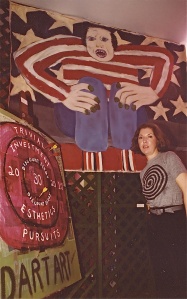 Janet Paparelli with Art Dart Board, an audience participation piece involving free, throwing darts, Oil and Collage on Particle Board and Silent Majority, Oil on Canvas, 70″ x 90″, both works, 1984)
Janet Paparelli with Art Dart Board, an audience participation piece involving free, throwing darts, Oil and Collage on Particle Board and Silent Majority, Oil on Canvas, 70″ x 90″, both works, 1984)
Inaugural Nada exhibition at the Coral Cafe on Coral Way, Coral Gables, Florida.
(1984)
——————————————-
Let’s call this the How To Section:
Cityscape with Large Eye (Paris) July 1982 [My subconscious must have been a real mess in 1982.]
Pastel on Paper 22.5″x30″
How does one know if one is working with abandon?
One is completely unaware of the world around one, of why one is choosing one action over another–every mark one makes is a surprise. There’s a sense of pleasure and enjoyment, in every action, every color selection, every mark. There is no sense of concern about composition or of artifice such as proportion, values, brushstrokes–anything at all that might inhibit the doing. There’s a sense of joy and there is no hesitation, no going over things relentlessly in one’s mind. There is just action and happiness, action and fulfillment, action and result.
That’s how it feels. No sitting on a stool looking at the work for an hour and then running up to the canvas and making a mark.
Artist on Studio Stool Miami, 1980
You just move through the painting the way you would move through water as you swim with ease. Being part of the water. The experienced swimmer doesn’t have to think of form after having lots of experience, the rules do become part of one,
Ball point pen sketch in an old journal.
However, unlike swimming, when one forgets the rules in doing art, one doesn’t sink, but rather, rises to the surface and hopefully, rises above the surface.
Golden Spheres (8/10/94)
Alkyd on Canvas 66″ x 54″
Did I write myself into a corner?
20th Century T.V. Reflection Jan. 1982
(Alternative Title: Where Am I? Where Am I?)
Pastel, Water Color, and Oil Pastel on Paper 30″x22.5
Janet Paparelli’s journals and writings have been requested by the Smithsonian Institution to be included in their collection of artist’s papers and writings, known as The Archives of American Art. In 1996 a representative of the Smithsonian spent a couple of hours at Paparelli’s studio, viewing journals and visuals with text which had been recommended for inclusion in the archives. After some time, spent in silence, the Smithsonian representative browsing through journals while sitting at a drafting table, Paparelli waiting in silence, interrupted: “Is this the kind of work you are looking for?” Happily the answer came back: “Yes. This is exactly what we are looking for.”

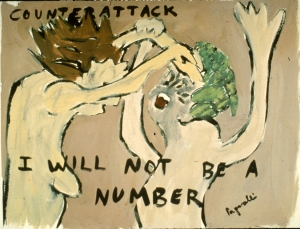
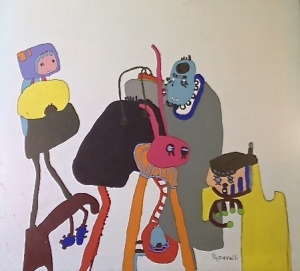
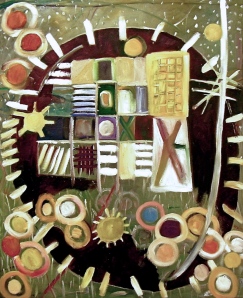
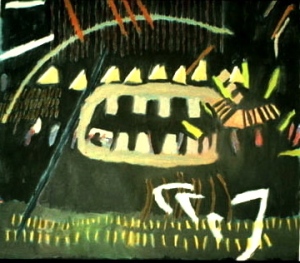
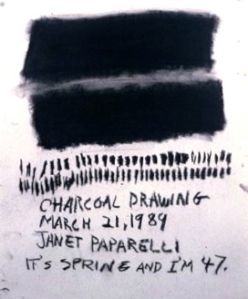
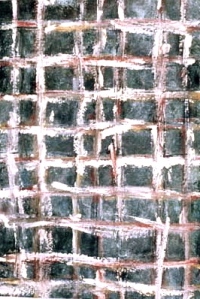
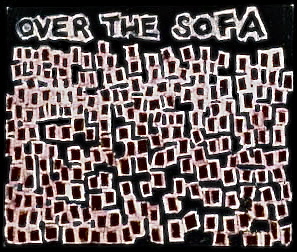
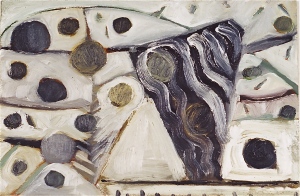
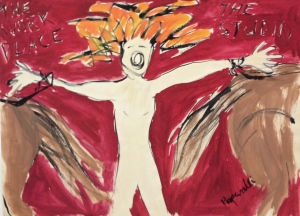
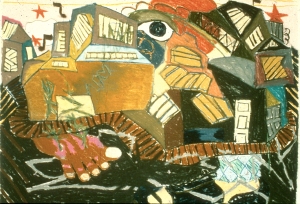
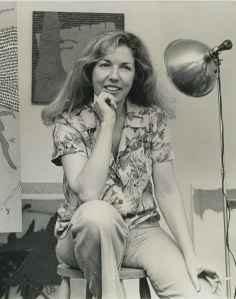
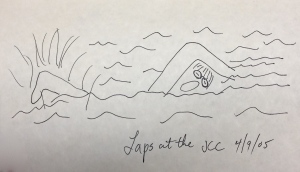
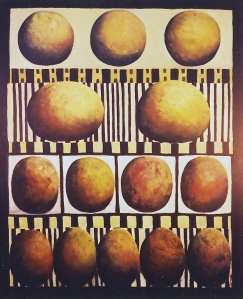
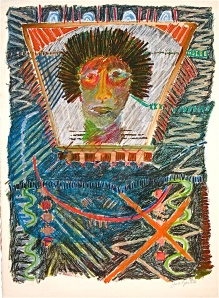
Hi jp,
This is really interesting. Halfway through I thought, “you have (i.e. one has) to be a really experienced artist to paint with abandon” or a complete novice.
Later, when you compared it to swimming, I remembered how I used to feel (from about ages 10-16) when everyone was out of the house and I would just paint… absolutely sublime, totally oblivious to anything else. It’s what I loved to do and when they took their week’s holiday in the summer I begged to stay home alone just to paint. Total freedom.
Good writing and good thoughts and good art (though I do like some more than others…does that mean anything?).
Thanks for sharing and hope you’re well.
Bev
>________________________________ > From: paparelliblog >To: bevkagan@att.net >Sent: Saturday, October 25, 2014 4:41 PM >Subject: [New post] Painting with Abandon — Artwork and Text by Janet Paparelli > > > > WordPress.com >janetpaparelli01 posted: ” Me and the Art Dog 2/82 Pastel on Paper 9.5″x13.5″ In writing about the subject of painting with abandon, I can foresee myself writing my way into a corner. As I mentally browse my work of the last 35 plus years, I ask myself a previously” >
Thanks, Bev. I loved your comment and was happy to have struck a chord. Janet
It was so good to see both work that I remember and work that I’ve not yet seen before. I hope that all is well with you. >
We’ve both spent the better part of our lives in art, you in music, and I, in visual art. We’ve both had our small successes and some folks to appreciate our efforts. I’m sure you have developed a rather interesting philosophy about what you do, as I have expressed in the blog about what I do. It is interesting to put one’s thoughts about the past years’ efforts into words. I’m very excited about doing this and in writing more essays, probably also illustrated. I hope you will view those, too. The best to you in your work, which I know is your world as much as fine art is mine.
Friends always.
In reading your blog, Janet, I can’t help but think of your extensive background in literature and your interest in collaborations between John Cage and his friends in the visual arts. “Creating” with abandon transcends the visual arts and includes music and the printed word.
In your selected paintings here, you’ve painted with abandon in several distinct ways. Certain works are distinctly Surrealist, such as Biting In, 1981,Talking About It, 1971, and Me and the Art Dog, 1982. Certain others are Abstract Expressionist, such as White Painting with Triangles, 2002. And some recall German Expressionism, such as Counter Attack, 1984.
Painting with abandon is not tied to a specific style or school of painting. It is an attitude one can feel in such diverse masters as Claude Monet, Berthe Morisot, Jackson Pollock, Lee Krasner, Wilhem De Kooning, Helen Frankenthaler and Jean-Michel Basquiat. Your insight into the psychology of the creative process will appeal to many artists of today regardless of their individual techniques and motifs.
Charles, each time you have commented on my work or the work of another over the years, you surprise me with your uniquely unexpected point of view. Whether it is in the press, in a video, or in person, your comments give me an insight into works of art done, not only by myself, but also by others. I always agree with what you say and see things that you point out, which I had not considered previously, whether it is about my own work or the work of another.
I find the same to be true of your philosophical insights and, most surprisingly, even of your more quotidian insights. Thank you so much for taking the time to read the text of my blog, notice how the use of images of work done over the years is used to subtly illustrate the text, and even mention one thing I was very proud of–having mined the appropriate photos from my catalogue of work in a way which made the matches meaningful.
I am so happy that you identified exactly what the blog was meant to accomplish and my method of accomplishing it. Thank you for the compliment of giving my effort that kind of time.
I’m very happy to have my words included in your blog, and I really appreciate the permalink feature. I look forward to exploring the websites of others who comment.
Thanks Charles. Comments like yours, with substance, help to create a dialogue and elevate the character of the blog keeping the exchanges intelligent. Of course, I welcome all comments and support from friends and followers.
Janet, I am so proud to have known you. You deserve praise for your work. I always loved it.
Congratulations.
Love
James Taylor
Piano player.
Hey, Jimmy! Your music at the “whatever” House was always great and definitely memorable. You certainly are ambidextrous! Thanks for the comment; I hope you are getting along well. I can see your great smile in my mind’s eye. Jan